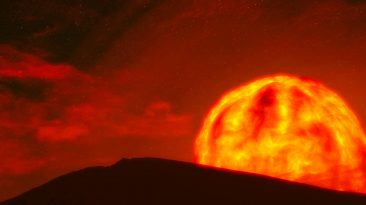An unexpected guest has made its way into our Solar System. It’s an interstellar object, an ISO. And it’s tumbling through space in a way that can’t be explained by gravity alone.
These ISOs pass through our Solar System occasionally, but only for a small window of time. They’re basically giant mystery boxes floating around in space, filled with secrets.
So, what if we manage to catch this? Where did it come from? And could data collected from a captured ISO change the way we think about our Solar System? And even the Universe?
Alright, WHAT IF is officially on the case. What would we have to do to snag one of these floating bundles of mystery? Well, let’s start with our top suspect, Oumamua.
Oumuamua made its way past Earth in 2017, and has been described by researchers as “absolutely nothing like anything else in our Solar System.” New computer simulations revealed a possible origin story for the interstellar object.
They suggest that a planet was ripped to pieces by its home star, leaving behind a wake of long, thin fragments. Some of these fragments would have been launched into space, and millions or billions of years later, Oumuamua landed in our Solar System.
That means if we managed to catch Oumamua, and others like it, we could potentially learn the secrets of dead alien planets. I know it’s a bit of a leap, but think of the possibilities!
But first, we have to catch the darn thing. In order to observe an ISO, timing is everything, so we have to act fast.
Richard Linares, of MIT, has proposed the concept of a “dynamic orbital slingshot for rendezvous with interstellar objects. He suggested using static satellites enabled by a solar sail to cancel out the sun’s gravitational force, no matter how far away it is. This would create a propulsive force, allowing the satellite to hover in place indefinitely.
Essentially, these satellites would be on a stakeout for any ISOs. So, let’s say our stakeout operation is a success, and we manage to catch one. What does that mean for us?
Well, it would be incredible, for starters. When Oumuamua was discovered in 2017, it was unlike anything we’ve seen in our Solar System, which also means it was incredibly confusing.
If we catch an ISO, we might be able to learn about how quickly and commonly objects transit between solar systems, helping us understand the feasibility of the interstellar travel between stars. As in, finding out that we may not be alone in the Universe.
And that’s just one of the potential secrets an ISO could unlock. They may contain valuable resources we could mine. This might open up an entirely new age of humanity, with new technology, and more.
The bad news is, humans don’t usually like to share their toys. There would be huge debates over who gets to keep the ISOs. We would need a massive amount of coordination to deal with our latest discovery. And that’s if a government even tells the public that we captured an ISO in the first place.
Why would a goverment keep it secret? Well, I’m not saying the ISO has aliens, but its an alien object. Still awesome. Sadly, we’re still a long way away from developing the technology to capture interstellar objects.
Having said that, we do have the drive, ambition, and motivation. Once we are able to observe more interstellar objects, it will be easier to identify them, and it may become easier to study them. There are still a lot of secrets out there in the Galaxy, and who knows what we might find?
Subscribe to What-If on YouTube or follow the show on Facebook Watch.
Sources
- “To catch an interstellar visitor, use a solar-powered space slingshot”. Sara Cody, 2020. MIT News.
- “‘Oumuamua And Borisov Are Just The Beginning Of An Interstellar Object Bonanza”. Bartels, Meghan. 2019. space.com.
- “‘Oumuamua: The First Interstellar Object”. Mann, Adam. 2019. space.com.
- “Should Earthlings Chase ‘Oumuamua Into Interstellar Space?”. Oberhaus, Daniel. 2020. Wired.
- “Strange interstellar object could be a shard from a dead planet”. nationalgeographic.com
- “Bizarre comet from another star system just spotted”. MICHAEL GRESHKO, nationalgeographic.com.
- “How many of our comets come from alien solar systems?”. 2020. Science | AAAS.



























